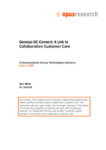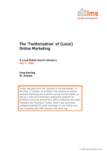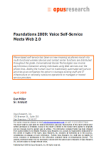The FCC has made great strides toward making its information and resources accessible to the public at large.
Web 2.0
Webcast: Rich Phone Apps and Enterprise 2.0 Customer Care
Webinar On-Demand Listen Now! In this webcast, as part of the Thought Leadership Series, Opus Research and SpeechCycle discuss the next generation of phone-based customer care applications and services. It’s nothing short of the transformation of the IVR 1.0 to… Read More ›
Genesys UC-Connect: A Link to Collaborative Customer Care

Featured Research
UC-Connect, from Alcatel-Lucent’s Genesys Telecommunications Labs, makes significant strides toward collaborative customer care. The mechanism derives “agent state” and leverages “presence” information in tracking the availability of remote and back-office employees. However, its “Interaction Preview and Auction” could be a game changer in promoting more collaborative customer care.
Advisories are available to registered users only.
For more information on becoming an Opus Research client, please contact Pete Headrick (pheadrick@opusresearch.net).
The ‘Twitterization’ of (Local) Online Marketing

Featured Research
Twitter has gone from the “margins to the mainstream” in less than 12 months. In so doing it has become an almost essential marketing and customer service tool for brands, as well as a news and information distribution platform for publishers and even government. While companies and larger marketers are flocking to Twitter, there’s also enormous, untapped potential for small businesses to use Twitter as a free marketing and CRM vehicle in the same way.
Advisories are available to registered users only.
For more information on becoming an Opus Research client, please contact Pete Headrick (pheadrick@opusresearch.net).
Disaggregation’s Destiny: Recombinant Telephony
Webinar: Cisco’s Mike Bergelson will join Dan Miller and Orange Lab’s Mark Plakias in a webcast, “Recombinant Telephony: Voices from the Cloud” on Wednesday, May 13th (10AM Pacific/1PM Eastern). Held in conjunction with BrightTalk, Click here to register.
In November 2005, in a book entitled “The Pebble and The Avalanche” Moshe Yudkowsky, a physicist who now serves as Chair of the Midwest Speech Technologies Association laid out the tenets of the concept he calls “disaggregation.” Using examples like the growth of the Internet, the introduction of the personal computer and breakup of AT&T, he describes how innovation results when energy is released in busting big things into smaller, more flexible or agile pieces.
He’s right, of course, and the breaking up of monolithic companies, IT infrastructure or political systems releases levels of creative energy that fuel revolution and results in the positive disruption of current practices. Yudkowsky’s era of disaggregation coincides with the Internet-era’s prevailing trend toward “disintermediation.” This “double dis” has resulted in Internet-based communications patterns and Web-based marketplaces where “peer-to-peer” communications put prospective buyers into direct conversations with the people or businesses offering the goods or services that they seek.
Ironically, the era of disintermediation and disaggregation has created a market for new intermediaries and integrators. These are the folks that help put all the pieces back together in new, truly useful ways through a process I’m calling “recombinance.” The result is “recombinant telephony” and it is tightly connected to some major trends and memes like unified communications, collaboration and conversational access.
Reassembly = Recombinance
The word “recombinant” is most closely associated with “DNA,” describing the biochemical bi-product of gene-splicing or the repairing of pieces of DNA as part of genetic engineering. In a way, this scientific method of “recombinance” has become manifest in the second generation of Web services (Web 2.0) where adding a dash of “collective intelligence” with Web infrastructure and easy-to-use development tools or programming languages has led to the rapid development and introduction of new services and modes of communications and eventually business plans.
Twitter, of course, is the most recent example – an immediate message-handling service built loosely on the pieces of SMS, Web services, an online registry and a blogging infrastructure. It has been the inspiration to new modes of search, discovery, customer care and support (with hooks into SalesForce.com’s CloudForce), information dissemination and general entertainment. And as creative Twitter-types develop a set of rich applications that link Twitterers to software and Internet-based services that help them find and interact with other people (or businesses) independent of time, distance and barriers, Twitter can eventually become the dominant mode of communications and commerce for an attention-deprived generation What’s more, this communication will cross all national borders, corporate firewalls and networking constraints.
Recombinance Brings Creativity and Agility to Telecom App Development
Recombinant telephony transcends talk of unified communications and traditional contact center management methodology. In the recombinant world, customer care professionals (or volunteers) can be in their homes or on mobile devices in local coffee shops. From virtually anywhere they can monitor and reply to activity across a number of channels – email, SMS text, websites, blogs and microblogs (meaning all those tweets on Twitter).
The magic is in a well-understood API designed to give third-party developers the tools and hooks into the broadband Internet to fiercely encourage rapid-fire innovation. To point, at eComm2009, held in the Bay Area in March, a number of firms, including IfByPhone, Voxeo, Jaduka, Ribbit (now owned by BT) and Adhearsion showed off their API-support of the developer community. They distribute SDKs with sample code, hold tutorials and fund “BarCamps” or coding sessions that yield very interesting mash-ups like phone-based access to Twitter or speech-enabling Yahoo! Local.
The end-products may sometimes underwhelm, but the speed at which new applications and services are developed, tested, deployed or discarded under the new regimen is stunning. The new architectures and support infrastructures have caught the attention of incumbent carriers and infrastructure providers. BT’s purchase of Ribbit (for US$105 million) is but one example of the value that established network operators see in adding the energy and efforts of aggressive innovators to their resource mix.
Our Menus Have Changed … Really!
The pebble has been dropped. Proprietary systems have been both cracked and benignly hacked. A library of reusable programming elements grows and grows, and, in many cases, it is there to be shared in collaborative efforts. In other cases, the inner workings of systems are exposed for use by all (developers and end-users alike). A dramatic example is Fonolo.com, a company that paid its employees to “power dial” though the IVR systems of scores of big companies so they could map all the branches in each menu. Fonolo.com’s disaggregation efforts now allow customers to select exactly where they want to join a phone conversation with a particular company. No queues, no waiting.
What if companies voluntarily “published” their IVR interactions and made them available to Fonolo.com? The result would be shorter queue times (which equates to lower telecom costs), happier customers and more accurate renderings of the “site navigation” – which is especially important in the rare cases that “our menus have changed” is a true statement.
Recombination is inevitable. Economic and technological imperatives have blown the speech processing, call processing and application processing worlds apart. Creative forces are compelling developers to put them back together in new ways. The results, when we indeed come out of this bad economy, are bound to be beneficial.
Foundations 2009: Voice Self-Service Meets Web 2.0

Featured Research
Phone-based self-service has taken on new meaning as phones morph into multi-functional wireless devices and contact center functions are distributed throughout the globe. Conversational Access Technologies now involve asynchronous interaction among individuals using Web services over the phone lines. Adding the human touch to traditionally automated self-service activities gives companies the option to leverage existing staff and IT infrastructure or outsource operations to managed or hosted service providers.
Featured Research Reports are available to registered users only.
For more information on becoming an Opus Research client, please contact Pete Headrick (pheadrick@opusresearch.net).

